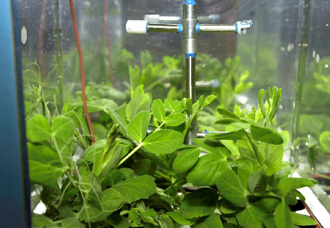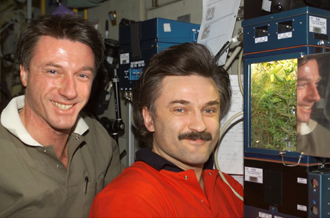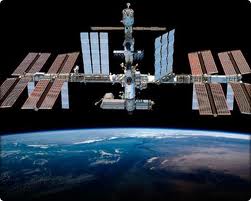

In the image shown above, zucchini is taking root inside of a plastic bag aboard the International Space Station.
It was recently announced by the Beijing-based Center for Research and Cosmonaut Training that Chinese tests are underway to develop vegetable tanks for growing fresh food on Mars and the Moon.
Given this announcement, it seemed like a good idea to explore NASA’s current space cultivation operations.

Named for the ancient Russian goddess of spring, the Lada chamber aboard the ISS has been testing methods for growing plants in the space station’s microgravity atmosphere. The Lada was delivered during 2002 by a Russian Progress spacecraft, and continues to serve as a great example of international cooperation.
The chamber has two individual modules, which allow for comparison of growing techniques. It is a small, wall-mounted chamber, and relies only on 60 watts of light.

The Lada has assisted scientists studying how plants grow in the microgravity, humidity, and temperature of the ISS’ environment. By studying root modules, we are able to learn if spacecraft contaminants affect the plants in any dangerous ways. We are given some insight, too, into how we may maximize the number of plant cycles for long voyages through the cosmos. We must be able to safely ensure an uninterrupted supply of air, water, and food during these voyages.
There have been no genetic alterations noticed in the plants grown aboard the ISS, which include several types of salad and string beans. Very recently a type of small wheat was harvested, and there are plants to cultivate tomatoes soon. By the end of the year, it is expected that the fluorescent bulbs will be replaced by LED bulbs, which last for a much longer period of time.

Is it time for NASA to begin a technology share with the Chinese space agency CNSA, and to begin working on this technology together? Should NASA begin to develop this technology with Russia for operation on another planetary surface? Either way, with much talk of the sequester and NASA lately, we must join together to write our representatives and voice support for the funding of NASA and the ISS.
Check out Penny4NASA’s popvox application, which makes it easy to contact your local representatives:
Or, you can help by signing this petition to help repeal the sequester’s cuts on NASA’s spending in public outreach and its STEM programs:
Be sure to check out their Facebook page, too: Penny4NASA